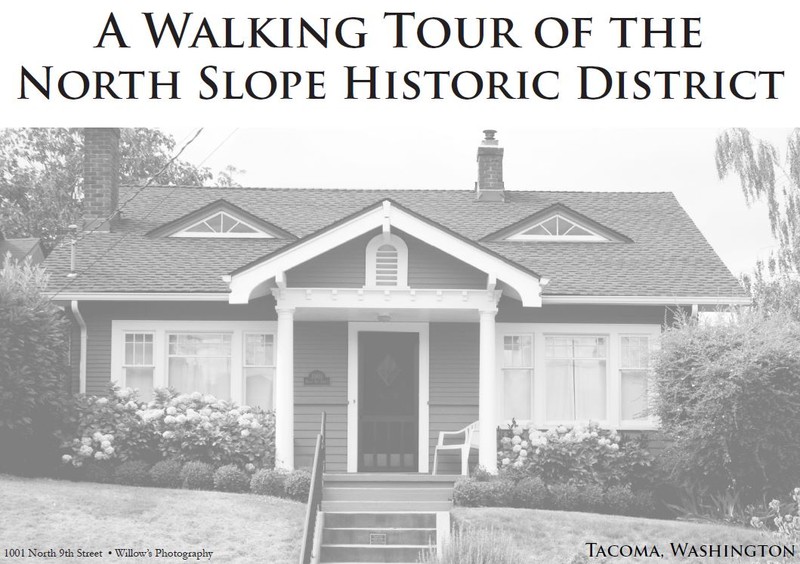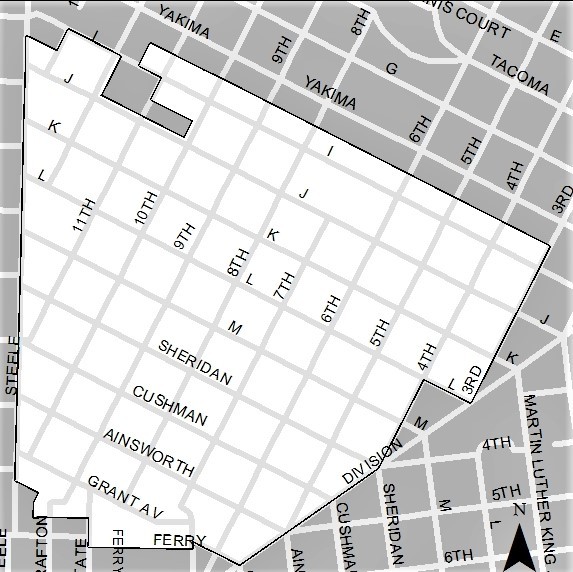North Slope Historic District
Introduction
Text-to-speech Audio
This walking tour begins on North J Street, between North 9th and North 10th, with the home located at 911 North J Street. A link to the full tour is included in the notes below.
The North Slope Historic District is a residential neighborhood of 228 acres containing 1,285 homes, making it one of the state’s largest historic districts and one of the largest west of the Mississippi. The North Slope district was settled primarily as a residential streetcar suburb with a wide variety of architectural styles. It is on the National, State, and Local Registers of Historic Places.
Images
A Walking Tour of the North Slope Historic District

Map of the North Slope Historic District

Backstory and Context
Text-to-speech Audio
Originally known as “Job Carr’s Hill,” most of the district consisted of Tacoma’s pioneer founder Job Carr’s 166-acre farm, which he purchased from the Northern Pacific Railway for $6.00 in the 1860s. Carr (1846–1887) founded Tacoma in 1864 directly below the district on the shores of Commencement Bay. Beginning in the 1880s, he sold off much of the farm to be platted for homes, but he and his family retained a 10-acre plot until 1920.
The district had three waves of development tied to the fortunes of the city. The railroad reached Tacoma in 1883 via Portland, but even so the city’s population in 1885 was only 7,000. In 1890, just two years after the completion of the Stampede Pass Tunnel linked Tacoma directly with Chicago, the population was 36,000. To accommodate this influx, streetcar lines were built out from downtown along Division Avenue and 6th Avenue. In 1889, real estate tycoon A. C. Mason built a streetcar line out to Point Defiance and bridged several deep gulches that had hindered development of Tacoma’s North End. With easy transportation downtown, Job Carr’s Hill quickly became a premier residential district with some 45 homes built from 1888 to 1893 for the bankers, real estate brokers, financiers, and railroad professionals of Tacoma’s boom. But building stopped following the 1893 crash, and was not helped when the Northern Pacific moved its headquarters to Seattle in 1895 or when the Alaska Gold Rush began on Seattle’s docks causing thousands of Easterners to by-pass Tacoma.
By 1900, Tacoma’s economic fortunes were looking up. Commencement Bay was ringed with saw mills and shingle mills churning out fine lumber, shingles, and millwork for houses in California and back East. Even the Champs-Elysees in Paris was paved with fir “cobbles” from Tacoma. Tacoma was growing again as was the North Slope with some 100 new homes added from 1902 to 1912. Well-off lumbermen, attorneys, and the new retail businessmen were building homes here. Tacoma was at the height of its political power when it was joked that Governor Ernest Lister could “holler” from his porch steps in the North Slope to the Lieutenant Governor, the House Speaker, and Chief Justice.
Following World War I, with better automobiles and roads, America’s wealthy began the first suburban exodus from the cities to palatial estates in nearby enclaves. Tacoma’s wealthy headed south to Lakewood. In their place came the growing American middle class: teachers, salesmen, government workers, and small business owners. In the North Slope the remaining large plots were divided and sold off, and from 1919 to 1929 another 120 homes were built, mostly modest bungalows, Tudors, and Cape Cods. Development largely ended following the Great Depression.
During the 1950s and 1960s the North Slope was largely stable, but increasingly populated by the working class as the new automobile suburbs drew much of the middle class from America’s cities. However, by the 1970s and 1980s, North Slope residents saw their neighborhood under attack. Large houses were divided into apartments or worse, torn down and replaced by cheaply built six- and twelve-plexes. When residents’ requests for zoning changes fell on deaf ears at city hall, Tacoma’s Historic Preservation Officer and North Slope resident Valarie Sivinski suggested creating a historic district.
Initially, the residents’ skepticism was only exceeded by that of city hall. The first district created in 1995 only included most on North J Street. Soon residents on other streets realized the advantages of joining the historic district, and in 1998 most of North K, North M, and parts of North I were included in the district. Finally, in 2000, an additional 350 properties were added, extending the boundaries of the North Slope to its current size. In 2002 the district was added to the Washington Heritage Register and the National Register. However, the work did not end there. Fearful that historic zoning overlay would not be strong enough, North Slope residents worked with the city to create a new underlying zoning category, Historic Mixed Residential – Special Review District, which specifically gives the historic district’s design guidelines precedent in all land use decisions. The zoning category was adopted in 2006.
The North Slope Historic District
The residents of the North Slope appreciate the special character of the neighborhood. This character is maintained, in part, by its inclusion on the Tacoma Register of Historic Places, which helps preserve the architectural character of the historic district through regulation of exterior alterations and new development. The designation won’t prevent changes—it helps insure that changes are appropriate to the style of the individual structure and the context of the district. The historic status of the district provides owners with economic incentives for building rehabilitation.
Regulations are administered by citizens serving on the Tacoma Landmarks Preservation Commission, using a set of design guidelines developed for the North Slope. Only exterior elevations and property improvements are regulated; there is no regulation of interior changes or exterior paint color. The primary concern is to retain the original building character and materials; if replacement of building elements is necessary, the preference is to replace with like materials.
Benefits of Owning Property in a Historic District
- Rehabilitation expenses may be eligible for the Special Valuation Tax Assessment program
- Protection from incompatible alterations and new construction
- Protection from demolition of historic properties
- Guidelines and advice provided to assist homeowners when they plan an alteration
- Flexibility in building code requirements to protect historic structures
- Protection of property values
Sources
A Walking Tour of the North Slope Historic District. Tacoma, WA. Historic Tacoma Press, 2008.
A Walking Tour of the North Slope Historic District. Tacoma, WA. Historic Tacoma Press, 2008.
City of Tacoma Historic Preservation Office
